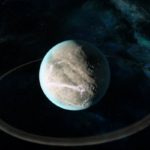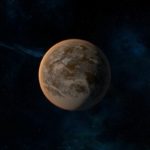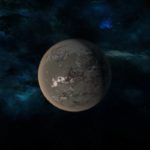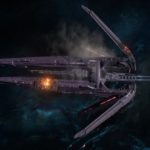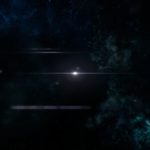System Specs:
- Stellar Mass: _ Sol-masses
- Stellar Class: _
- Luminosity: _ Sol
- Planets: 4
- Moons: 0
- Asteroid Belts: 0
- Asteroids: 0
- Objects: 1

–
Planets Directory:
- Hipaal
- Phostaan
- Pas-16
- Masiid
- Ark Leusinia
–
Hipaal:
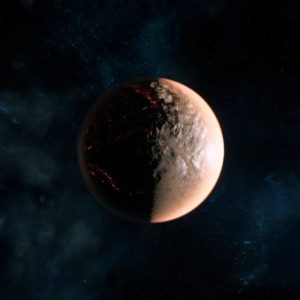
- Orbital Distance: 0.5 AU
- Orbital Period: 0.3 Earth-years
- Keplerian Ratio: 1.389
- Radius: 3,256 km
- Day Length: _ Earth-hours
- Atmospheric Pressure: 0.00 atm
- Surface Temp: 518 °C
- Surface Gravity: _ g
- Mass: _ Earth-masses
Much of Hipaal’s molten surface solidifies during the northern and southern hemispheres’ short winters, reshaping the landscape every year.
–
Phostaan:

- Orbital Distance: 1.3 AU
- Orbital Period: 1.2 Earth-years
- Keplerian Ratio: 1.526
- Radius: 6,046 km
- Day Length: _ Earth-hours
- Atmospheric Pressure: 0.47 atm
- Surface Temp: 18 °C
- Surface Gravity: _ g
- Mass: _ Earth-masses
Phostaan is largely barren, bit its atmosphere is theoretically capable of producing rainfall. Powerful localized storms could appear as often as three or four times a year.
Anomaly
River
DATA:
- Source: Rainfall
- Composition: Liquid water
- Length: 2285 km
ANALYSIS:
A violent and recent rainstorm must have occurred to create this river. The water will be absorbed or evaporated soon.
–
Pas-16:
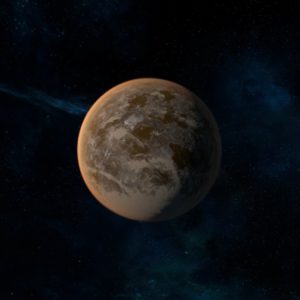
- Orbital Distance: 5.3 AU
- Orbital Period: 9.5 Earth-years
- Keplerian Ratio: 1.65
- Radius: 6,693 km
- Day Length: _ Earth-hours
- Atmospheric Pressure: 0.03 atm
- Surface Temp: 32 °C
- Surface Gravity: _ g
- Mass: _ Earth-masses
Pas-16 travels in a synchronous orbit around its sun, leaving one side always lit and the other always dark. The reason for this is unclear, but a thread of Scourge within its path is suspect.
–
Masiid:

- Orbital Distance: 6.2 AU
- Orbital Period: 11.9 Earth-years
- Keplerian Ratio: 1.683
- Radius: 8,529 km
- Day Length: _ Earth-hours
- Atmospheric Pressure: 0.00 atm
- Surface Temp: -53 °C
- Surface Gravity: _ g
- Mass: _ Earth-masses
Platinum and cobalt form the outer layer of Masiid’s surface, pitted and cracked by innumerable meteor strikes.
Anomaly
Aluminum
DATA:
Aluminum
ANALYSIS:
A valuable light metal. This deposit is close to the surface and relatively easy to mine.
–
Ark Leusinia:

Description
DATA:
- Ark name: Leusinia
- Stasis pod count: Projected 20,000, currently detecting 12,000
- Status: Multiple hull breaches, power levels sub-operational
ANALYSIS:
Named after a mythical asari kingdom of wealth and learning, Ark Leusinia is built along similar specifications to Ark Hyperion. Sensors currently show heavy damage to many decks, minimal power, and few life signs.
Mass Effect: Andromeda
After reaching Andromeda and encountering the kett, Ark Leusinia came under attack by a group of specialized kett hunters known as the Decimation. Stolen kett navigational data allowed the ark to flee through the Scourge while evacuating as many civilians as possible, but constant harrying eventually forced the ark to go into hiding until rescue arrived.
If Pathfinder Ryder follows the trail leading to Leusinia’s whereabouts, it is discovered to be heavily damaged from boarding parties of Decimators and without sufficient power to use the main drive. It turns out that a powerful mass effect field generator holding a section of the hull in place is hooked up to Leusinia’s power systems, and hasn’t been turned off ever since some asari evacuated the ship attempting to get away from the invaders. After a prolonged battle with the kett, the necessary energy is diverted to the drive.
Before the Leusinia can escape, it is intercepted by a Decimator warship, which fires several missiles on a weakened section of the ark. The ship is saved thanks to the biotic powers of asari Pathfinder Sarissa Theris and Cora Harper.
After being escorted to safety, Ark Leusinia is now docked at the Nexus to offload the remaining colonists from stasis and undergo extensive repairs.
–

